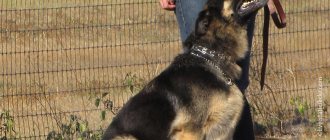Why do we need the “die!” command?
Of particular user value for the “die!” does not exist, but it can be used as a game situation to distract the animal. A familiar, cheerful command, which is always associated with the game, helps the pet relax during the stress caused by a trip or visiting an exhibition. A new place of residence or the appearance of a new pet in the family - these factors make the dog nervous, and the usual game with the inevitable treat will reduce the level of anxiety.
Teaching any trick, except for mandatory commands, develops the dog’s mental abilities, disciplines it and trains it to unconditionally fulfill all the owner’s requirements. Joint activities strengthen the friendship between the dog and the person and teach them to better understand each other.
How to teach a dog the command Die
What not to do?
You should not try to teach the dog this technique by applying a strong and unpleasant force to the dog, turning it over and laying it on its side with your hands. Such an action may cause resistance or fear in her, after which learning will be significantly hampered.
When training, how you manipulate your hand with the treat is important. Movements must be clear and practiced. You need to be patient and repeat this exercise with your dog many times. The transition to working with the dog at a distance should be gradual, increasing the distance away from it and introducing into the exercises a gesture that is given simultaneously with the command.
The dog's precise work at a distance will only be demonstrated when he learns this technique in close proximity to you.
Source
Starting age
Try to teach your puppy the command “die!” possible as early as three months. To do this, the baby must understand two things: that for each completed command he is entitled to a treat, and that after completion a fun game awaits him.
But still, a dog that has outgrown adolescence learns this command much faster. At one year of age, a dog trained in basic basic commands very quickly understands what is required of it. An adult dog himself strives to learn something new that will arouse the approval of his adored owner.
Consolidation of a skill
As soon as after the command “die” the dog begins to immediately take the desired position, it is necessary to devote time to consolidating the skill. First, you need to explain to the animal that after taking the desired position it is necessary not to move for some time. To do this, you can try stroking your pet's tummy or side for a while. Soon the dog will remember that it needs to lie still and wait for reward. In order for the pet to stand up, the owner must pat himself on the knees and loudly say “come to me.”
You need to gradually replace edible treats with verbal rewards, and very soon the pet will be falling funny just to please the owner.
Since the “die” command is not included in standard training programs, you will have to teach your dog a funny trick yourself. With the right approach, the process will only bring pleasure.
Source
Training methods and nuances
There are two ways to teach a dog to “die” on command: by reinforcing the desired behavior and by purposefully practicing the command.
How to teach a dog the die command
Reinforcing desired behavior
By rewarding the desired behavior, the command “die” can be achieved within a few weeks or even days.
The teaching principle is as follows:
- When the dog is lying on his side, but not sleeping, he is given the voice command “die!” and a characteristic hand gesture is made. The gesture can be anything at the owner's discretion. It is important that it is clear and understandable for the pet. After a few seconds, the dog is praised and given a treat.
- After a short pause, they cheerfully and cheerfully pronounce the command “come to life!”, accompanying it with a clap of their hands. The dog jumps up, for which he receives a treat.
- The next time the dog lies calm, the command is repeated. This happens until the dog understands why he is being rewarded.
- It may take several dozen repetitions until the dog, from any position, begins to independently carry out a command after a gesture or voice order.
Development of a conditioned reflex
The second, more common method is to train the words “die!” and “come alive!” conditioned reflex.
The command “lie down!” is the basic command for practicing this trick. From a lying position, it is most convenient to force the dog to lie on its side. To do this, the pet is given the command “die!”, during which the right hand with a tidbit clutched in it is moved to the left or right of the dog’s head. Use your left hand to hold the pet so that it does not jump up.
When the dog falls on his side while trying to grab the treat, he is praised and allowed to take the treat.
After waiting a few seconds, they clap their hands and command “come to life!” If necessary, encourage the dog to jump up by lightly pulling him by the collar. Be sure to give the animal a treat.
How to teach a dog the die command
Nuances
Since the command is a game one, the intonation with which the words “die!” and “come to life!” must be fun, stimulating, and intriguing.
After clearly practicing from one position, you need to practice performing it from different positions: standing, sitting, in motion, at a distance.
We teach the dog to freeze in the “Die” position for a while
If you want your pet to remain still for several seconds, gradually increase the time between the voice command and giving the treat.
So, to train your dog to lie in the “Die” position for 10 seconds, do the following: take 10 pieces of treat, squat down, command “Die” and reward your dog every second. While the dog is lying down, say “Wait, wait.” After feeding the last piece, say “Done!” and let her change position.
Feeding the dog while he is lying down
Then start giving the treat not every second, but after 2 seconds, then after 4 seconds and then increasing. This way the dog will get used to lying quietly and waiting for the final command “Ready”.
Source
Common mistakes
The biggest mistake is being forced to perform this trick. It leads to suppression of the dog’s desire to cooperate with the owner and to a negative attitude towards the learning process.
Very often, the owner allows the dog to jump up, without restraint and even without a permission command. This leads to the fact that the animal, having heard the command “die!”, does not even try to lie down, but joyfully demands a treat.
There is no need to be upset if the pet does not want to “die” on command. Most likely, after a few weeks, the dog will be happy to learn a new trick. Animals are also not in the mood, they are affected by magnetic storms and moon phases, so you should not insist on immediate implementation. It is much more important not to lose the dog’s trust.
Development of a reflex
There are several methods for teaching a dog the “die” command. It is easiest to train an animal that already knows how to perform the “down” command. You just need to add another conditional signal. After the dog lies down, carefully turn it onto its side, remembering to say the key phrase. You can turn your pet on its back, and to strengthen the reflex, instead of giving out treats, scratch its tummy.
Also, before turning your pet over, you can snap your fingers loudly. The dog will associate the click with performing a rollover. And performing the coup, in turn, will lead to the desired reward.
If the dog does not know the “down” command, and the owner’s plans only include learning the “die” command, then the training process can be slightly simplified.
- Order the animal to sit.
- Hold the treat in your hand and smoothly move it from your pet’s nose to the floor. The animal will not lie down right away, but will definitely bend over for a treat. If you place a treat 10-15 centimeters from your pet, you can expect the animal to take a reclining position.
- At the moment when the pet almost reaches the treasured treat, you need to loudly say “die” and turn the animal on its back.
It is best to carry out training according to this scheme on a soft surface, so as not to accidentally throw the dog onto a hard floor. If the animal understands that this is a game, it will not be afraid of sudden movements of the owner. Therefore, it is important to use only positive intonations, stroke your pet often, and show your satisfaction with what is happening in every possible way.
Useful tips
To quickly and easily consolidate a skill, use a game form of training, take into account the four-legged mood, stick to consistency and avoid too long sessions. The following tips will help you with this:
- Maintain interest in the process by purchasing new toys.
- Stop training if you notice fatigue or discomfort.
- Increasingly increase the complexity of the exercises, not forgetting to repeat already established skills.
- Limit your study time to one hour.
At the same time, it is recommended to learn another skill – “Quiet”. It makes it much easier to control unwanted barking.
"Voice!"
There are several ways to teach this command. The simplest one is to show your dog his favorite toy or treat and then hide it behind his back. Usually an active pet immediately begins to demand them back, barking loudly. At this moment, the required item should be immediately given to the dog, while simultaneously accompanying your action with the command “Voice!” After a few repetitions, your pet will learn to bark just by hearing the command.
A more “advanced” variation of the “voice” command is its volume variations - when your dog will be able to respond to the commands “louder” and “quieter” (the latter skill is very useful, because it allows you to prevent the dog from barking inappropriately in a given situation) .
Shot
So, after a certain number of lessons, a smart dog will begin to fall down as if knocked down when a tasty morsel looms on the horizon (that is, in your hand). And just a moment before she starts to fall over, point your outstretched finger-gun at her and say: “Dysch!”
Repeat. A little more patience and training - and this new command and the associated action will be forever imprinted in the dog’s brain.
Expert: Sophia Yin, veterinarian and animal behaviorist, author of Perfect Puppy In 7 Days
“Die” is not a command that is taught in training courses. This trick is typical for the circus arena or performances of “home-grown” animal theaters. In most cases, this “number” is just part of a somersault or flip. Teaching an animal this command is not at all difficult, the main thing is to understand the basics.
The command is performed while lying on your side and without moving. This must continue until a command or sign is given canceling the order to lie still. Standards for this command have not been developed, but it is customary for the dog not to react in any way to its surroundings while performing the trick. Often the command sounds like “Sleep” to remove negative connotations.
During the “Die” command, the dog must lie motionless on its side or back.
When starting to teach any command, you should select a signal indicating the end of the exercise.
If the animal changes position before the signal is given, the command is considered unfulfilled and the dog does not receive any reward.
The function of the command is everyday convenience. Using this command, you can stop the “outrages” of an animal that is overly excited during the game. Instead of sending your pet to its place, you can give the command “Die/Sleep”. The playful form of this trick allows the animal to obey more willingly, gradually developing endurance.
Brief conclusions
Teach the "Fu" command with good intentions and consistency, demonstrating your superiority, but not deviating from the principles of equality.
Dogs are especially sensitive to intonation:
- If you have to accustom an adult dog to a categorical ban, it will be difficult and time-consuming, but quite possible. It all depends on how loyal the dog is to you, trusts you and makes contact.
- Basic education is not only prohibitive commands. When starting training, teach your dog to “analyze” and distinguish between commands. Otherwise, the pet will react solely to the owner’s behavior and the harshness of his voice.
- Start working on training in a quiet environment and one-on-one, then the puppy will be collected and respond correctly to your requests.
- When you can’t train your four-legged friend to follow prohibitive commands, don’t give up and don’t stop training. Contact a specialist.
If the dog is still not quite adequate in situations when the command “Fu!” is given, pull it back, shorten the leash, do it strictly and without emotion. Since the dog always senses intonation, the animal will soon begin to correctly perceive prohibitions.
It just takes time. And don't use physical violence - it won't cause the right reaction. If the dog can already handle other commands, then you won’t have any problems with this one either - just be patient.











